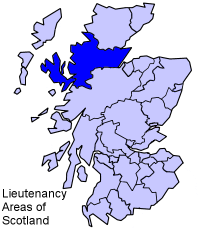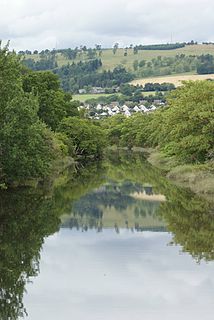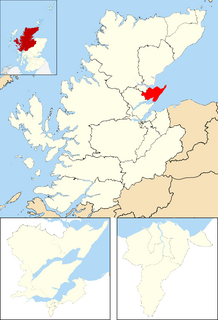
Cromarty is a town, civil parish and former royal burgh in Ross and Cromarty, in the Highland area of Scotland. Situated at the tip of the Black Isle on the southern shore of the mouth of Cromarty Firth, it is 5 miles (8 km) seaward from Invergordon on the opposite coast. In the 2001 census, it had a population of 719.

Dornoch is a town, seaside resort, parish and former royal burgh in the county of Sutherland in the Highlands of Scotland. It lies on the north shore of the Dornoch Firth, near to where it opens into the Moray Firth to the east.

Dingwall is a town and a royal burgh in the Highland council area of Scotland. It has a population of 5,491. It was an east-coast harbour that now lies inland. Dingwall Castle was once the biggest castle north of Stirling. On the town's present-day outskirts lies Tulloch Castle, parts of which may date back to the 12th century. In 1411 the Battle of Dingwall is said to have taken place between the Clan Mackay and the Clan Donald.

Tain is a royal burgh and parish in the County of Ross, in the Highlands of Scotland.

Ross and Cromarty, sometimes referred to as Ross-shire and Cromartyshire, is a variously defined area in the Highlands and Islands of Scotland. There is a registration county and a lieutenancy area in current use, the latter of which is 8,019 square kilometres in extent. Historically there has also been a constituency of the Parliament of the United Kingdom, a local government county, a district of the Highland local government region and a management area of the Highland Council. The local government county is now divided between two local government areas: the Highland area and Na h-Eileanan Siar. Ross and Cromarty border Sutherland to the north and Inverness-shire to the south.
Ross and Cromarty was a county constituency of the House of Commons of the UK Parliament from 1832 to 1983. It elected one Member of Parliament (MP) using the first-past-the-post voting system.

Invergordon is a town and port in Easter Ross, in Ross and Cromarty, Highland, Scotland. It lies in the parish of Rosskeen.

Evanton is a small village in Easter Ross, in the Highland council area of Scotland. It lies between the River Sgitheach and the Allt Graad, is 24 kilometres (15 mi) north of Inverness, some 6.5 km (4.0 mi) south-west of Alness, and 10 km (6.2 mi) northeast of Dingwall.
Wick Burghs, sometimes known as Northern Burghs, was a constituency of the House of Commons of the Parliament of the United Kingdom from 1832 to 1918. It elected one Member of Parliament (MP) by the first past the post voting system.

The Dingwall Canal was a short tidal canal running from the town of Dingwall to the Cromarty Firth in the county of Ross and Cromarty, Scotland. It was completed by 1819, to provide better access to the town, but was not a commercial success, and was abandoned in the 1880s after the arrival of the railways.

Fortrose Cathedral was the episcopal seat (cathedra) of the medieval Scottish diocese of Ross in the Highland region of Scotland. It is probable that the original site of the diocese was at Rosemarkie, but by the 13th century the canons had relocated a short distance to the south-west, to the site known as Fortrose or Chanonry. According to Gervase of Canterbury, in the early 13th century the cathedral of Ross was manned by Céli Dé (culdees).
Thomas Brown was a Scottish architect operating throughout Scotland in the mid-19th century, primarily involved with prison design. Despite training under Thomas Brown Senior he was not related to him.

St. Duthus Football Club is a senior Scottish football club playing in the North Caledonian Football League based at Grant Park in the town of Tain in the Scottish Highlands.

Gustavus Aird (1813–1898) was a Scottish minister of the Free Church of Scotland who served as Gaelic Moderator of the General Assembly in Inverness in 1888. He was an active campaigner against the Highland Clearances.

Tain and Easter Ross is one of the 21 wards used to elect members of the Highland Council. Between the Cromarty Firth and the Dornoch Firth and east of the Cromarty Firth ward, it includes the town of Tain and the Seaboard Villages. It elects three Councillors.

Dingwall Town Hall is a municipal structure in the High Street, Dingwall, Highland, Scotland. The structure, which is now used as a museum, is a Category B listed building.

Selkirk Town House is a municipal building in the Market Place, Selkirk, Scottish Borders, Scotland. The structure, which is used as a local history museum is a Category A listed building.

Tain Tolbooth is a municipal building in the High Street, Tain, Highland, Scotland. The structure, which is used as a courthouse, is a Category A listed building.

Invergordon Town Hall is a municipal building in the High Street in Invergordon in the Highland area of Scotland. The structure, which is used as a community events venue, is a Category B listed building.

Wick Town Hall is a municipal building in Bridge Street, Wick, in the Highland area of Scotland. The structure, which is used as a local events venue, is a Category B listed building.


















